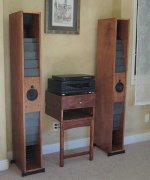So as my amplifier project gets underway, I will need some speakers for it, so why not make them as well? I've done work modifying headphones but have never done speaker work with sound being so crucial in my mind.
I've drawn up an idea in Google Sketchup:
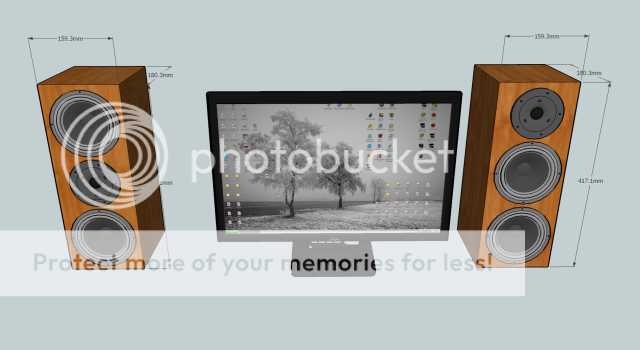
The speakers and monitor models aren't mine, I got them off the Sketchup database. I want to use 4" or 4.5" main drivers and 1" tweeters. The cabinet will be most likely made of MDF or a cheap hardwood. Veneered MDF is also a possibility, because I like how easy MDF is to work with and how cheap it is, but I hate the look of it immensely.
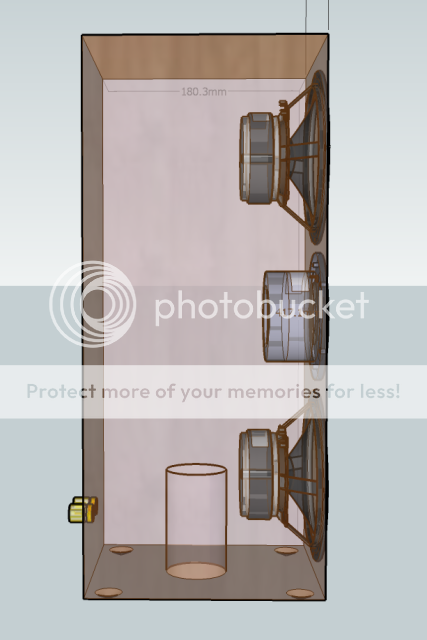
To maximize bass I want to have the speakers on small rubber or metal feet and have a bass tube in the bottom. I don't know how long to make that tube yet.
In terms of drivers I've been debating between expensive and less expensive, weighing pros and cons. I think I'm between using Pioneer 4.5" full range speakers
http://www.mcmelectronics.com/product.aspx?productid=51-075
Or the much more expensive Dayton 4" reference full-range drivers
http://www.artofnoiseaudio.com/speakers_daywoof4.php
For tweeter I've been looking at Dayton Reference tweeters, but they cost a fortune.
http://www.artofnoiseaudio.com/tweeters.php
The amp is putting a substantial dent in my college-going pocket, so theres not too much money left for these speakers. Could I get away with something like these cheap tweeters from MCM and have decent sound still?
http://www.mcmelectronics.com/product.aspx?productid=53-526
So, some questions for the experts.
Is there a point to having two of the full-range drivers in each cabinet or is that overkill? Would they drown out the tweeter? What kind of crossover situation would that leave me in?
If I do a two-full one-tweet arrangement, would having the sweeter on the top or in the middle be better? The speakers will mostly be heard at head-level and at a distance of only a few feet normally.
I'm not a big bass guy, I enjoy the perfect balance between treble and bass, so I know I won't have a problem with using 4" full-range drivers as my lowest drivers. I built a boombox during the summer that used a pair of bookshelf speakers and it has just the right amount of bass. I think that if I seal the cabinet and add the bass tube then there will be more than enough bass.
Thanks for the help.
I've drawn up an idea in Google Sketchup:

The speakers and monitor models aren't mine, I got them off the Sketchup database. I want to use 4" or 4.5" main drivers and 1" tweeters. The cabinet will be most likely made of MDF or a cheap hardwood. Veneered MDF is also a possibility, because I like how easy MDF is to work with and how cheap it is, but I hate the look of it immensely.

To maximize bass I want to have the speakers on small rubber or metal feet and have a bass tube in the bottom. I don't know how long to make that tube yet.
In terms of drivers I've been debating between expensive and less expensive, weighing pros and cons. I think I'm between using Pioneer 4.5" full range speakers
http://www.mcmelectronics.com/product.aspx?productid=51-075
Or the much more expensive Dayton 4" reference full-range drivers
http://www.artofnoiseaudio.com/speakers_daywoof4.php
For tweeter I've been looking at Dayton Reference tweeters, but they cost a fortune.
http://www.artofnoiseaudio.com/tweeters.php
The amp is putting a substantial dent in my college-going pocket, so theres not too much money left for these speakers. Could I get away with something like these cheap tweeters from MCM and have decent sound still?
http://www.mcmelectronics.com/product.aspx?productid=53-526
So, some questions for the experts.
Is there a point to having two of the full-range drivers in each cabinet or is that overkill? Would they drown out the tweeter? What kind of crossover situation would that leave me in?
If I do a two-full one-tweet arrangement, would having the sweeter on the top or in the middle be better? The speakers will mostly be heard at head-level and at a distance of only a few feet normally.
I'm not a big bass guy, I enjoy the perfect balance between treble and bass, so I know I won't have a problem with using 4" full-range drivers as my lowest drivers. I built a boombox during the summer that used a pair of bookshelf speakers and it has just the right amount of bass. I think that if I seal the cabinet and add the bass tube then there will be more than enough bass.
Thanks for the help.
Speaker design requires a lot of specialized knowledge.
For your first build, you would be much better off building someone else's design. Fortunately, there are a ton of them out there to choose from.
Try zaph audio for starters, there are lots of good projects there in various price ranges. Here's an MTM that looks similar to what you describe:
http://www.zaphaudio.com/BAMTM.html
For your first build, you would be much better off building someone else's design. Fortunately, there are a ton of them out there to choose from.
Try zaph audio for starters, there are lots of good projects there in various price ranges. Here's an MTM that looks similar to what you describe:
http://www.zaphaudio.com/BAMTM.html
MDF is the way to go, it will give you fewer unwanted resonances than hardwood,
Two full range drivers is probably overkill, at high frequencies multiple drivers give rise to comb filtering which mucks up the frequency response,
Tweeter on top is probably best for near field listening
The bass port on the bottom will limit your placement options, I'd put it on the front, but if the speakers aren't going to be close to the wall, it can go on the back.
How long to make it - download WINISD (for free), it's easy to use and you can model the bass response and have the port dimensions calculated for you
Have a look at how these guys have made small speakers to get an idea of how to procede:
http://www.zaphaudio.com/
http://www.troelsgravesen.dk/Diy_Loudspeaker_Projects.htm
http://www.rjbaudio.com/projects.html
http://www.humblehomemadehifi.com/
Two full range drivers is probably overkill, at high frequencies multiple drivers give rise to comb filtering which mucks up the frequency response,
Tweeter on top is probably best for near field listening
The bass port on the bottom will limit your placement options, I'd put it on the front, but if the speakers aren't going to be close to the wall, it can go on the back.
How long to make it - download WINISD (for free), it's easy to use and you can model the bass response and have the port dimensions calculated for you
Have a look at how these guys have made small speakers to get an idea of how to procede:
http://www.zaphaudio.com/
http://www.troelsgravesen.dk/Diy_Loudspeaker_Projects.htm
http://www.rjbaudio.com/projects.html
http://www.humblehomemadehifi.com/
Mattthegamer,
Try this. You should be able to find some suggestions you'll like:
http://undefinition.googlepages.com/diy-speakerhelp
Try this. You should be able to find some suggestions you'll like:
http://undefinition.googlepages.com/diy-speakerhelp
mattthegamer463 said:The speakers and monitor models aren't mine, I got them off the Sketchup database.
Do you remeber anything one could use as a search term to find them... the driver models look particularily well executed.
The cabinet will be most likely made of MDF or a cheap hardwood.
If you search you'll find extensive discussion of the merits of various building materials. We use baltic Birch almost exclusively (_ some Bambbo ply when the project can afford it). Hardwood takes a real pro to make something that holds together, That said i was just looking at some laminated pine board available at Home Depot. 8'x 3/4: and 16 or 11.75" wide. People have used solid pine with good results and a laminated board would be less problematic. We will likely play with some of this to see how it holds up.
MDF we will not use for building speakers (except for some minor roles) -- it does burn nicely thou.
using Pioneer 4.5" full range speakers
A favorite of GYChang (one of his attached)... available at PE, they also have a number of versions of an inexpensive 1" domes that have been used extensively with the larger Pioneer B20.
http://www.diyaudio.com/forums/showthread.php?postid=1587836#post1587836
A TMM with a simple cap on the tweeter, one Pioneer run fullrange, and another rolled off above the bafflestep would probably work out well.
dave
Attachments
Re: Re: First Time Speaker Project
I've used the laminated pine. 1" thick pine that I glued 1/8" bamboo ply to the front of. Sounded good, solid enough, the bamboo looked nice. It was easy to do and cheap.
planet10 said:People have used solid pine with good results ....
I've used the laminated pine. 1" thick pine that I glued 1/8" bamboo ply to the front of. Sounded good, solid enough, the bamboo looked nice. It was easy to do and cheap.
@ dave
http://sketchup.google.com/3dwarehouse/details?mid=882154aab31d483e130bc0755682f7f3
http://sketchup.google.com/3dwarehouse/details?mid=d05c2dfdb34f38433e8a91ffbc9ffd64&ct=mdrm
http://sketchup.google.com/3dwarehouse/details?mid=b8a5307c51164dac78128d32fc0f2897&ct=mdrm
Theres the 3 that the guy had made, they're quite good and easily scalable to whatever size you want.
Ill have a wander around Home Depot looking at suitable materials.
Do you think there would be a noticable difference between the Dayton 4" reference and the 4.5" Pioneers? Would this difference be worth the extra money for the Daytons ($22 for 2 Pioneers vs. $52 for 2 Daytons)
@ everyone else:
thanks for the links, Ill sift through all that info over the course of the weekend and work out a new design model.
http://sketchup.google.com/3dwarehouse/details?mid=882154aab31d483e130bc0755682f7f3
http://sketchup.google.com/3dwarehouse/details?mid=d05c2dfdb34f38433e8a91ffbc9ffd64&ct=mdrm
http://sketchup.google.com/3dwarehouse/details?mid=b8a5307c51164dac78128d32fc0f2897&ct=mdrm
Theres the 3 that the guy had made, they're quite good and easily scalable to whatever size you want.
Ill have a wander around Home Depot looking at suitable materials.
Do you think there would be a noticable difference between the Dayton 4" reference and the 4.5" Pioneers? Would this difference be worth the extra money for the Daytons ($22 for 2 Pioneers vs. $52 for 2 Daytons)
@ everyone else:
thanks for the links, Ill sift through all that info over the course of the weekend and work out a new design model.
mattthegamer463 said:@ dave
thanx
Do you think there would be a noticable difference between the Dayton 4" reference and the 4.5" Pioneers? Would this difference be worth the extra money for the Daytons ($22 for 2 Pioneers vs. $52 for 2 Daytons)
I'be not heard either but going by my gut i might get the Pioneers, it is bery unlikely i'd get aytons...
If you want to spend more money, these are interesting
http://www.madisound.com/catalog/product_info.php?products_id=8470
Bur consider... building speakers is addictive, there is a lot to learn, you learn by practise....
Start with the Pioneersm put em in a box, mod the drivers,,, what you learn will leave you better prepped to choose your next project.
dave
PeteMcK said:"MDF ... -- it does burn nicely thou" - the glue that binds it together probably gives off lovely toxins...
The fire has to be really hot and outside....
dave
mattthegamer463 said:Ill have a wander around Home Depot looking at suitable materials.
Note that the birch plywood carried by some Home Depots isn't worth using for anything but braces. The sheet I bought a few months ago had face veneers just .010" thick that flake if you look at them side ways and are easy to sand through (versus > .030" for normal plywood and .050" for decent 18mm 13-ply Baltic Birch), voids that showed up when I cut the baffles, and warped once cut.
If you're going to use plywood instead of MDF, get it at a decent lumber yard. For small enclosures you can get decent 30x20" sheets of 18mm Baltic Birch from Woodcraft or Rockler for $20 each.
PeteMcK said:
Another reason to avoid MDF at all.
dave
Matt -
Here are a few things to think about, from personal experience. Think through the resources, time, and skills you have, and where you want to spend the effort:
1) Do you have access to a good workshop space with a table saw, router, bits, jigs, etc and have the necessary skills and experience using them? I have all of that, and still spent many $ on new router bits, jasper circle jigs for driver cut outs, new clamps, a new blade for the saw, etc. etc. etc. (I admit that I have a tool "problem.") Be realistic about whether you have the time, skills, access to tools, and $ to build the cabinets yourself, and what your expectations are for how perfectly they turn out. If you decide to go for it, GREAT! It is very satisfying, but can also be very frustrating. Without a lot of practice, it won't turn out perfectly. My first set of cabinets turned out reasonably well, but there's a lot I learned along the way and it took far longer than I thought it would.
You should consider the time / cost trade off of just buying pre-made cabinets - see Parts Express for example. Then you can focus on the rest of it.
2) Do you want to select the drivers, measure them, and do the crossover design yourself? I'm assuming you have a PC and a sound card, then with some small investment in external hardware, mic, preamp, and a free copy of Speaker Workshop you can really go down the rabbit hole measuring the electrical parameters and frequency response of the drivers, and then design the crossover. After that you can get carried away with the free version of Eagle PCB design software to design your own boards for them, obsess over capacitor and inductor choices, and so on. This can soak up your free time for months, depending on how obsessive you are.
Or you can start with someone else's design (zaph audio, as suggested by others, or parts express, etc.) and get to the end a lot faster.
3) DIY is not necessarily cheaper. For example, I have started on a subwoofer. Of course, I have gone completely overboard, it would have been cheaper and way quicker to just buy the cabinet, plate amp, and driver from Parts Express and put it all together, and I'd be shaking the house right now. Instead I'm thinking about buying myself a drill press for Christmas to help finish the project.
To sum up, why are you thinking DIY? Is it for the learning experience and process? Or is it to knock out a cheap set of speakers? Understanding your goals will help you figure out how much of it you want to do yourself, and how much you want to buy or rely on design work done by others. For me, the fun and enjoyment is in the process, learning, and discovery along the way.
None of this is meant to discourage you, quite the opposite. This forum is amazingly helpful and an incredible source of information. I had no idea a few years ago when I was looking for information on repairing an old set of Minimus 7 speakers and found DIYaudio that I would have gone down the path I have. Good luck with your project!
Here are a few things to think about, from personal experience. Think through the resources, time, and skills you have, and where you want to spend the effort:
1) Do you have access to a good workshop space with a table saw, router, bits, jigs, etc and have the necessary skills and experience using them? I have all of that, and still spent many $ on new router bits, jasper circle jigs for driver cut outs, new clamps, a new blade for the saw, etc. etc. etc. (I admit that I have a tool "problem.") Be realistic about whether you have the time, skills, access to tools, and $ to build the cabinets yourself, and what your expectations are for how perfectly they turn out. If you decide to go for it, GREAT! It is very satisfying, but can also be very frustrating. Without a lot of practice, it won't turn out perfectly. My first set of cabinets turned out reasonably well, but there's a lot I learned along the way and it took far longer than I thought it would.
You should consider the time / cost trade off of just buying pre-made cabinets - see Parts Express for example. Then you can focus on the rest of it.
2) Do you want to select the drivers, measure them, and do the crossover design yourself? I'm assuming you have a PC and a sound card, then with some small investment in external hardware, mic, preamp, and a free copy of Speaker Workshop you can really go down the rabbit hole measuring the electrical parameters and frequency response of the drivers, and then design the crossover. After that you can get carried away with the free version of Eagle PCB design software to design your own boards for them, obsess over capacitor and inductor choices, and so on. This can soak up your free time for months, depending on how obsessive you are.
Or you can start with someone else's design (zaph audio, as suggested by others, or parts express, etc.) and get to the end a lot faster.
3) DIY is not necessarily cheaper. For example, I have started on a subwoofer. Of course, I have gone completely overboard, it would have been cheaper and way quicker to just buy the cabinet, plate amp, and driver from Parts Express and put it all together, and I'd be shaking the house right now. Instead I'm thinking about buying myself a drill press for Christmas to help finish the project.
To sum up, why are you thinking DIY? Is it for the learning experience and process? Or is it to knock out a cheap set of speakers? Understanding your goals will help you figure out how much of it you want to do yourself, and how much you want to buy or rely on design work done by others. For me, the fun and enjoyment is in the process, learning, and discovery along the way.
None of this is meant to discourage you, quite the opposite. This forum is amazingly helpful and an incredible source of information. I had no idea a few years ago when I was looking for information on repairing an old set of Minimus 7 speakers and found DIYaudio that I would have gone down the path I have. Good luck with your project!
mattthegamer463 said:
To maximize bass I want to have the speakers on small rubber or metal feet
and have a bass tube in the bottom. I don't know how long to make that tube yet.
Thanks for the help.
Hi,
That will not work, you will restrict airflow too much.
Taller feet (~1") or move the port to the back panel.
Note that a few feet is nearfield and normal listening farfield.
http://www.zaphaudio.com/ZBM4.html
and
http://www.zaphaudio.com/ZMV5.html
Are possible options, high quality / cost drivers.
Use the reduced BSC option of the crossovers for nearfield.
Looking at all this information, I'm starting to think that building crossovers will be the toughest part so I think I will need to find a very simple one.
If I use two full range drivers in parallel (two 8-ohm Pioneers would give me 4-ohms impedence, same as my Amp) I wouldn't need crossovers, right? There would be nodal lines of interference in a setup like that though, yes? If both speakers are playing the same sounds at the same time they will interfere. Lack of tweeters might not sound so nice either.
I'm trying to find information on the Minimus 7 speaker's crossover since the pair I have have very simple crossovers, and the 7's use speakers almost identical to what I'll be using.
If I use two full range drivers in parallel (two 8-ohm Pioneers would give me 4-ohms impedence, same as my Amp) I wouldn't need crossovers, right? There would be nodal lines of interference in a setup like that though, yes? If both speakers are playing the same sounds at the same time they will interfere. Lack of tweeters might not sound so nice either.
I'm trying to find information on the Minimus 7 speaker's crossover since the pair I have have very simple crossovers, and the 7's use speakers almost identical to what I'll be using.
I found this website
http://www.the12volt.com/caraudio/crosscalc.asp#ccc
It makes crossover building seem very simple indeed, in fact I'm positive I could build a 1st order crossover for the tweeter and one for the midbass. They're really just a cap and a inductor coil. That website is quite helpful with their calculator.
Where might be a good place to set the crossover freqency at?
http://www.the12volt.com/caraudio/crosscalc.asp#ccc
It makes crossover building seem very simple indeed, in fact I'm positive I could build a 1st order crossover for the tweeter and one for the midbass. They're really just a cap and a inductor coil. That website is quite helpful with their calculator.
Where might be a good place to set the crossover freqency at?
Ubfortunately the XOs you build using those calcs is a shot in the dark... if you want to avoid building an XO (XOs are evil -- sometimes necessary but evil none the less) just start with a FR. For the price of 2 pair of pioneers, a pair of tweeters, you could do a project with a Fostex FE103 or FE127 that will blow the 2 way out of the water (not only my opinion -- read over here where chops is being bowled over by an FE103 in a cardboard box (after spending 1000s on a multiway)
http://www.diyaudio.com/forums/showthread.php?s=&threadid=132363
and you would avoid a lot of stress...
dave
http://www.diyaudio.com/forums/showthread.php?s=&threadid=132363
and you would avoid a lot of stress...
dave
Crossover design isn't as simple as just picking a frequency. Crossover frequency depends on the characteristics of the drivers, and many other factors have to be taken into consideration to generate an optimal crossover. With proper choice of drivers however it is possible get reasonable results with a simple crossover.
Go here: http://www.pvconsultants.com/audio/frdgroup.htm and start reading. Also read the project articles at www.zaphaudio.com to get some understanding.
Many of drivers available at Parts Express for example have .frd files available for download which means you don't have to measure the drivers yourself to do the crossover modelling.
[edit] and seriously consider what Planet10 said.
Go here: http://www.pvconsultants.com/audio/frdgroup.htm and start reading. Also read the project articles at www.zaphaudio.com to get some understanding.
Many of drivers available at Parts Express for example have .frd files available for download which means you don't have to measure the drivers yourself to do the crossover modelling.
[edit] and seriously consider what Planet10 said.
I've looked at Fostex drivers, but they're all ridiculously expensive. Could someone point me towards a place that sells them cheap? I could get four Pioneers and two Tweeters for only about $70 US. My new design is looking at only two Pioneers.
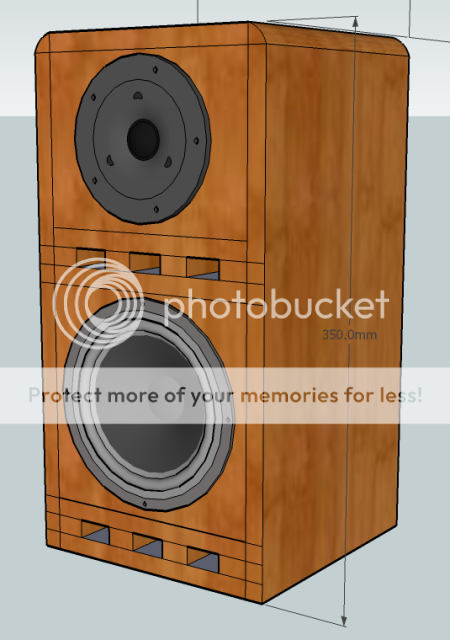
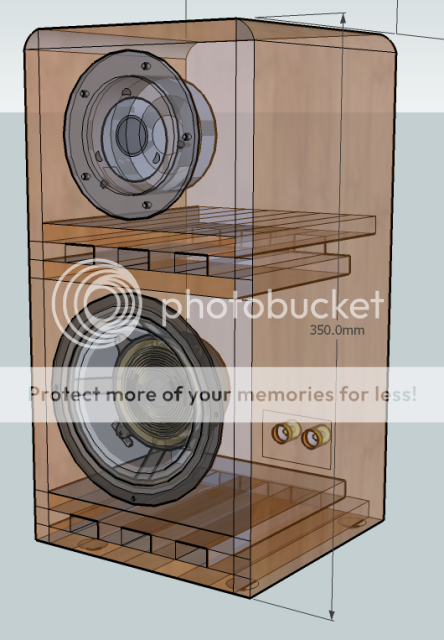

The idea was taken from:
http://www.humblehomemadehifi.com/Solo103.html
I know I can't build a acoustically perfect speaker. I just would like to make a simple custom speaker that sounds good. I am far from a trained ear. I am not an audiophile. I just want to hear nice sound, and I like to make things.
I appreciate what everyone is saying about mathematically modeling and designing my speakers around all this data, but its just far too overwhelming for me, and speakers are not my passion.
I'll keep reading and trying to figure stuff out to throw together a cheap, decent speaker set.



The idea was taken from:
http://www.humblehomemadehifi.com/Solo103.html
I know I can't build a acoustically perfect speaker. I just would like to make a simple custom speaker that sounds good. I am far from a trained ear. I am not an audiophile. I just want to hear nice sound, and I like to make things.
I appreciate what everyone is saying about mathematically modeling and designing my speakers around all this data, but its just far too overwhelming for me, and speakers are not my passion.
I'll keep reading and trying to figure stuff out to throw together a cheap, decent speaker set.
- Status
- This old topic is closed. If you want to reopen this topic, contact a moderator using the "Report Post" button.
- Home
- Loudspeakers
- Multi-Way
- First Time Speaker Project
